Harrington House, an imposing Grade II listed Georgian mansion on the High Street, Badsey, will have new owners later this year. It has stood the test of time for over 300 years, seen many changes and survived demolition in the 1960s.
It did not become known as Harrington House until the end of the 19th century, but will be referred to as such throughout this article. Here is its story.
* * * * *
When was the house built?
According to its official listing on the National Register of listed buildings, Harrington House dates back to the early 18th century.
Ownership by the Grove and Jones family
For much of the 18th century, the house was in the ownership of the Grove and Jones families. The first documentary evidence we have is in a will of 1754, made by 87-year-old Francis Grove, Gentleman, shortly before his death, when he bequeathed to his nephew:
All that my messuage or mansion house situate in Badsey aforesaid wherein I lately dwelt next the Sign House together with the barns, stables, outhouse, gardens, cottages, closes and one yard and three-quarters of a yard land of arable meadow and pasture lying in Badsey and the fields and commonable places and to the said messuage or mansion house belonging and which said premises are called or known by the name of Price’s or the Lower Living.
This is clearly the house now known as Harrington House which is next to the Manor House (which was originally known as the Seyne House).
Francis Grove (1667-1775) was the eldest of six children of John Grove. The Groves had lived in Badsey since at least the mid 16th century and probably earlier (but as the parish registers did not begin until 1538, it is difficult to confirm this). They were a prosperous family and owned a fair amount of land.
Francis was 28 when his father died in 1695. As the eldest in the family, Francis was bequeathed “the house wherein I now dwell and all the appurtenances and hereditaments thereunto belonging”. (The location of this house is not known, but it was probably not Harrington House.) Francis acquired considerable more land and property during his lifetime.
Francis Grove never married. It is likely that he, as a man of considerable means, was the person who caused Harrington House to be built, or substantially altered. One theory is that it was originally the kitchen for the manor house next-door. Or it could have been the farmhouse for Price’s Farm or Lower Living. There were certainly people in the village by the name of Price in the 16th century and early 17th century, so presumably they were then the owners and would have had some kind of house on the site.
At the time of Francis Grove’s death in 1755, his nephew, John Jones, was living in the house as tenant. John Jones (1703-1758) was the eldest son of Francis’ sister, Mary (1677-1762), who had married Joseph Jones in 1703.
The will also referred to two cottages across the road from Harrington House (known today as Orchard Way), which were left to Benjamin Harold and Mary Pythard (and thence to her daughter, Elizabeth Pythard). By the terms of his uncle’s will, John Jones was made responsible for erecting a cottage for the use of Francis’s sister, Martha Barber; this new cottage was to be built next to Benjamin Harold’s. Benjamin Harold was also granted the use of “the two lower bays of barning belonging to Prices Farm to inn the corn growing on his own land and to thrash out the same for his natural life” – this was presumably on the land at the back of Harrington House.
John Jones, too, was a bachelor and died only three years after his uncle. After his death, he bequeathed the house to his nephew, Joseph Jones, the son of his brother, William (1709-1784).
Joseph Jones (1740-1762) was not to enjoy his inheritance for long. He died in December 1762, aged just 22. He left all his property and land at Badsey to his sister Mary Bushell, who became an heiress at the age of 21. Mary had recently married John Bushell, a yeoman of Salford, Warwickshire, but she was widowed within the space of a year.
Following John’s death, Mary returned to her native village and took up residence at Harrington House which she had inherited. From a document that may be seen at Birmingham City Archives (Ref 361765), we know that on 18th September 1763, widowed Mary took out a mortgage for £300 with Jonathan Bishop.
On 22nd May 1764, Mary married John Darrill of Aldington and had five daughters whom she brought up at Harrington House. By 1787, the loan was still outstanding, and John and Mary contracted to borrow a further £1,300 from John Wilks.
After the death of John Darrill in 1794, Mary then sold the whole estate in 1795 (which included land that John Darrill had bought in Aldington), with the exception of the Orchard Way cottage which had been built for her sister, Martha Barber, in the 1750s. Mary spent her final years in reduced circumstances, dying at the Orchard Way cottage in 1821.
Ownership by the Harrington family, 1795-c1822
The new owner in 1795 was John Harrington of Holborn, London. The property was described as follows:
All that messuage or tenement with the barn, stables, dovehouse and other outbuildings, yard, garden, orchard containing one acre in Badsey And also all those several pieces or parcels sellions or rudges of arable land meadow and pasture ground to the said messuage or tenement belonging lying and being in the town fields liberties territories and precincts of Badsey containing together 68a 2r 2p more particularly described …..
There is no evidence that the Harringtons ever lived in Badsey. John Harrington (c1723-1807) was a trunkmaker of some renown. One of his trade cards may be seen in the London Museum, and some of his trunks may be seen in stately homes around the country, such as this one at A la Ronde in Devon.
John Harrington died in 1807. By his will made in 1804, with codicils in 1805, he left his freehold estate in Gunpowder Alley, London, and the leasehold houses at the corner of Chancery Lane, one of which he lived in, along with the stock in trade, bookstall and £1000 annuities to his son John. He left his freehold estate at Badsey to his three unmarried daughters, Mary (1754-1822), Elizabeth (1756-1818) and Sarah Harrington (1760-1838), who also lived in Holborn.
In October 1813, a notice was placed in The Morning Post advertising the sale or letting of Harrington House, describing it as “fit for the reception of a genteel Family”. Although it was the sisters who owned the estate, it was their brother, John, that placed the advertisement.
We know that the house must have been let rather than sold in 1813 as in 1815, at the time that the Badsey Enclosure Commissioners made their awards in 1815, sisters Sarah, Elizabeth and Mary Harrington were described as the owners of a house and homestead amounting to 1a 1r 11p – this was Harrington House and the land extending down to Badsey Brook. They also owned 45 acres of farmland which was at Claybrook in the north of the parish. In the Award Schedules, it is the eldest sister mentioned, described as “Mary Harrington and others”, but on the map, the name of the youngest sister appears, “Sarah Harrington”.
Elizabeth Harrington died in 1818 and Mary Harrington in 1822. In their wills (both made on the same day in 1808), they each left their portion of their father’s estate to their sisters. Sarah Harrington died in 1838 but there is no mention of an estate in Badsey in her will made in 1836. It is believed that, shortly after the death of her sisters, Sarah Harrington sold the Badsey estate.
Ownership by Thomas Scardefield, 1822-1828
From 1822, Harrington House was home to a young couple named Thomas and Jane Scardefield. Whether they bought the farmland that the Harringtons had owned in the north of the village is unknown.
Thomas Scardefield had been born at Litlington, Cambridgeshire, in 1792, but had lived in London from an early age. The Scardefields were well acquainted with the Harrington family, as Thomas’ grandparents, Thomas and Elizabeth Scardefield, who died in 1805 and 1807 respectively, both named John Harrington Junior as an executor in their wills.
Thomas Scardefield, aged 32, married Jane Robinson, 12 years his junior, at All Saints, Maidstone, Kent, on 31st August 1822. His father had died the year before and his mother some years before this. Mary Harrington had died in April 1822. As she was the second of the three Harrington sisters to die, leaving just Sarah Harrington, it is likely that a private sale was arranged some time in 1822 between the Harrington and Scardefield families. Thomas and Jane probably moved to Badsey soon after their marriage.
We know little about the Scardefields’ time at Harrington House, other than their tragic deaths in 1828, within three weeks of each other. According to various newspaper reports of the time, on the evening of 26th April, Thomas and Jane walked down to the orchard behind the house, in order to look at some young trees. The grounds of Harrington House extended as far as Badsey Brook. Jane fell into the water and Thomas rushed in to save her. After considerable difficulty, he managed to get her on to the bank. He then went back to the house to call for assistance. His neighbour at the Manor House, Lieutenant Edward Wilson, went to his aid and the two men returned to the brook. Jane Scardefield was on the opposite bank. Wilson rushed through the water to her assistance, but found her, in his opinion, “quite dead”. They took her back to Harrington House where friends and a medical man attempted to revive her.
Two days later, an inquest was held before Charles Best, Coroner. The Jury returned a verdict of Accidental Death. This did not stop some gossips, however, circulating false reports, implying that Thomas had not done enough to save his wife. Jane’s funeral was held at Badsey on 29th April.
It seems as though Thomas could not live without Jane as he made his will a fortnight later describing himself as being “of sound mind though broken-hearted …”. Within a day, he too was dead.
On 1st September 1828, Thomas Scardefield’s property was sold at auction at the White Hart Commercial Inn, Evesham. Lot 1 was Harrington House; the location of Lot 2 is unknown. The following description appeared in The Worcester Journal:
LOT 1 – An Ancient FREEHOLD MESSUAGE, TENEMENT, or FARM-HOUSE, situate on the west side and nearly in the centre of the pleasant Village of BADSEY, with the Rick Yards, Barns, Stable, Cart-houses, Cow-Sheds, and other necessary Outbuildings, together with a capital ORCHARD, and a large and productive GARDEN adjoining thereto.
The Messuage consists of two Parlours, two Kitchens, Dairy, Brewhouse, and Drink-house, three good Lodging-Rooms and two Attics; commanding a frontage of upwards of 50 yards, is well watered, and contains with the said Orchard, Two Acres, or thereabouts.
The Land is of the best quality, the poor rates are low, the roads good, the neighbourhood respectable; and from the contiguity of the Premises to Evesham, It is a truly desirable situation for a Dealer, Maltster, or Baker, as the Outbuildings might, at a trifling expense, be converted into commodious Granaries; or a Malthouse, on an extensive scale.
Ownership by the Appelbee family, 1828-1891
Following the Scardefields’ deaths, Edward Appelbee (1784-1851) bought Harrington House. The farmland at Claybrook, in the north of Badsey, was not included at this auction, but Edward Appelbee definitely bought that land at some point in his farming career.
Edward had been born at Snitterfield, Warwickshire, the eldest of nine children of Thomas Appelbee, a wheelwright, and his wife, Sarah (née Millbond). In 1819, he inherited a house and land in Badsey from his great-uncle, Edward Savage (Edward Appelbee’s maternal grandmother, was the younger sister of Edward Savage), described as a “freehold messuage, buildings, farm, lands and hereditaments situate in the township of Badsey”. This was the current-day cottages now known as Orchard Cottage and Barn Cottage, Mill Lane, and around 30 acres of land. It may have been at that point that Edward Appelbee moved to Badsey.
Just three months after the purchase of Harrington House, Edward Appelbee, then aged 44, married Elizabeth Loxley (13 years his junior) at Cropthorne in December 1828. The newly-married couple moved into the house where two children were born: Thomas (1831-1879) and Anne (1834-1867), who were both baptised at Badsey.
At the time of the 1841 census, the Appelbees had staying with them Elizabeth’s sister-in-law, Alice Loxley, and her two young daughters, Alice and Eliza. Elizabeth’s brother, Francis Loxley, a Bailiff, lived elsewhere in the village.
In 1842, Edward Appelbee took the opportunity to buy the neighbouring house, known today as Hollywood Villa. We know this from his will which he made in December 1848 in which he referred to:
….. my freehold estate late Mr Savage’s also all that my freehold estate late Mr Scardifield’s and also all that my freehold property I purchased of James Ashwin Esq all situate in Badsey …..
James Ashwin of Bretforton had bought Hollywood Villa in July 1842, which was part of a 76-acre estate belonging to William George Wilson of Portsmouth. He shortly afterwards sold Hollywood Villa to Edward Appelbee, together with an orchard across the road (where the present-day houses on the south side of Old Post Office Lane are situated) and a cottage on Old Post Office Lane (present-day No 29). It seems that Edward Appelbee did not buy the arable and pasture land, presumably because he already owned land at Claybrook. Like Harrington House, the land at Hollywood Villa, comprising nearly 2 acres, reached down to Badsey Brook and included a wheelwright’s shop (present-day 10A High Street), dovecote and outhouses.
In 1851, Edward was described as a farmer of 80 acres employing five men. His wife, Elizabeth, was listed on the census, but then crossed out with a note saying: “At Gloster” (she was staying at the home of her sister, Jane Davis, wife of Thomas Reynolds Davis, bookseller; there was presumably some family celebration going on, as other siblings were also staying). Thomas and Anne were still at home, Thomas working as a Banker’s Clerk, and Anne described as a Farmer’s daughter.
Edward died in December 1851 and the estate passed to his widow for the term of her natural life and then to be divided equally between his two children. On 16th September 1856, Elizabeth, now in her late fifties, sold at auction all the stock at Claybrook as she was described as “declining farming” and was letting the estate.
By 1861, both her children had married and left home (Thomas to Hannah Jerram in 1860 and Anne to her second cousin, William Gibbs, in 1857). Elizabeth, described as a landed proprietor, had her widowed sister, Ann Dingley, staying with her. There was also a house servant living there. In 1871, Elizabeth was all alone in the house with just one servant. Her sister, Ann, had died in 1863. Elizabeth Appelbee’s daughter, Anne Gibbs, had died in 1867, leaving a husband and five young children. Her grieving mother had a plaque installed in Badsey Church.
Elizabeth died at Badsey on 19th March 1880, having made her will the year before. By now, her son, Thomas Appelbee, had also pre-deceased her. He had died 14 months earlier, leaving his six children orphaned, as his wife had died in 1872, shortly after giving birth to their seventh child who also died. Elizabeth’s only surviving descendants, therefore, were her 11 grandchildren, all of whom were minors.
It took some time to sort out the estate and it was not until 11 years later that the houses and land were sold. In the meantime, Harrington House was let out to tenants. William Corbett, a 73-year-old widower, and described as an annuitant, lived there with his unmarried daughter, Georgina, aged 41, plus a servant. William Corbett died in January 1886 and, some time after this, Georgina went to live at Kempsey.
The next tenants were Samuel and Jane Johns and their four children: Joseph Thomas (1864-1928), Margaret Elizabeth (1865-1913), John Henry (later known as Henry John, 1869-1948) and Edward (1973-1921), all born at Bengeworth. They were living there at the time of the 1891 census on 5th April. Samuel Johns was described as a market gardener and his three sons were his assistants.
On 6th July 1891, the Appelbee estate was at last put up for auction at The King’s Head Hotel, Evesham, sold by the trustees of the will of Thomas Appelbee and his sister, Mrs William Gibbs. Nearly 70 acres was being sold in four lots. Harrington House and Hollywood Villa were Lot 1:
All that very desirable stone-built residence containing five bedrooms, attics, dining and drawing-rooms, back and front kitchens, pantry and usual offices with the pleasure and kitchen gardens, newly-erected stables, coach-house, large barn and sheds, also the adjoining stone-built cottage, shoeing forge, warehouse and out-offices, also the adjoining stone-built cottage, shoeing forge, warehouse and out-offices.
Also all that fine orchard at the rear of the above premises, running down to the Brook. The whole of this Lot contains 8A 1R 14P and is in the several occupations of Mr S Johns and Messrs Moore, Robbins and Addis, at an estimated rent of £52 per annum. This Lot has a frontage of about 70 yards to the Main Street in Badsey and has two double gate entrances, rendering it well adapted for being divided into separate lots for building sites.
Lots 2 and 3 were the orchard and cottage which Edward Appelbee had bought in 1842 from James Ashwin. Lot 4 was Claybrook which he had owned for much longer.
Ownership by the Jones and Johns families, 1891-1965
Arthur Edward Jones (1863-1950), a Badsey market gardener, who lived just across the road at the house now known as Oakleigh House, No 1 Old Post Office Lane, was the purchaser of Lot 1. Coincidentally, he was a great-great-grandson of Mary Jones (née Grove) whose brother, Francis, had built the house. Nearly a century earlier, Harrington House had passed out of the ownership of the Groves/Jones families when it was sold in 1795 by Mary Darrill (granddaughter of Mary Jones). Or perhaps it wasn’t a coincidence. We know from later acquisitions that Arthur Jones, who had a great knowledge of his own family history, bought property that had once been owned by his forebears. It is thought that it was Arthur Jones who first gave the house the name of Harrington House, as it was not until the 1890s that the name began appearing. As a keen Badsey historian, he would have been aware of the Enclosure Map with the name of Sarah Harrington clearly marked.
Arthur Jones’ father had died just six weeks before the auction, so perhaps this now enabled him to buy Harrington House.
Samuel Johns remained as the tenant of Harrington House. He died in 1900. In 1901, his widow, Jane, was living at Harrington House with Margaret and Edward. Next door at Hollywood Villa lived her son, Henry John, his wife, Ethel, and daughter, Margaret Clementine, who had been born in 1896.
In an interesting development, Arthur Jones, owner of the property, married Margaret Johns, his tenant’s daughter, on 8th October 1902 at St James’ Church, Badsey; the fine wedding was reported in The Evesham Standard. The reception was held at Harrington House.
Margaret went to live with Arthur at Malvern House (No 36 High Street), which he had recently bought (this was another acquisition which had originally been owned by his forebears for generations but had been sold in 1868). Twins, Ruby Winifred and Llewelyn Joseph were born the following July. When the twins were just ten years old, Margaret died, in August 1913.
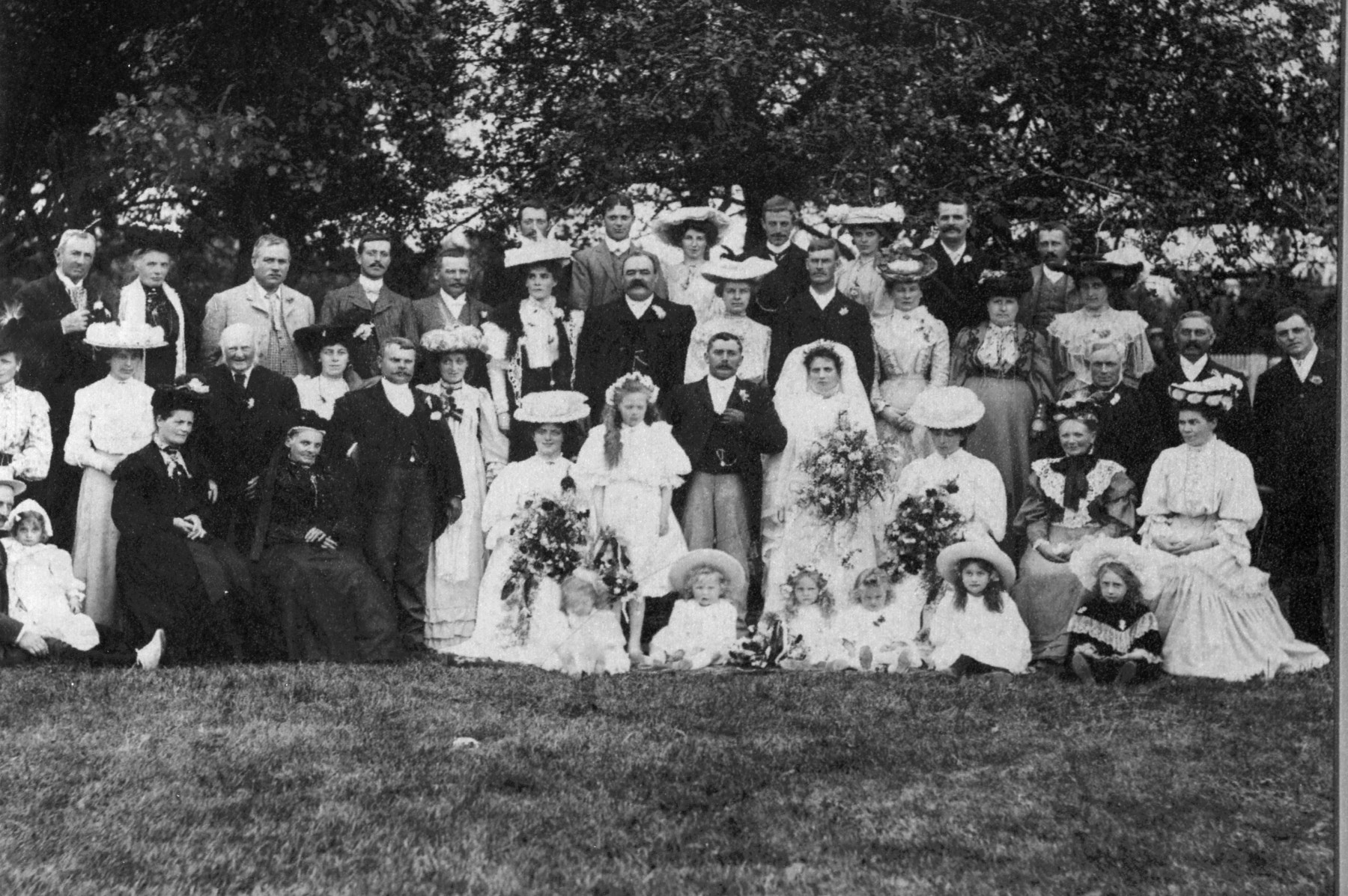
By 1911, Jane Johns’ youngest son, Edward, was listed as the head of household. He lived there with his wife, Alice (whom he had married in a lavish wedding in 1906, reported in The Evesham Standard of 4th August 1906), his mother, his son, Samuel Hemming Johns (1909-2001) and a servant. Edward and Alice went on to have two daughters: Lucy Christine (1912-1989) and Margaret Eileen Alice, known as Peggy (1913-1997). The two girls both attended Badsey Council School before being sent to private school.
In the nationwide valuation survey of land and property, which took place 1910-1915, Harrington House was inspected on 19th February 1913. It was described as follows:
Substantial stone and tile house, old but good repair: 2 front sitting-rooms, entrance passage, large kitchen, stone floor, larder, cellar store, 5 bedrooms, 2 small, one through other, 5 attic rooms. 2 wood and thatch barns, stone and tile coach-house and lofts over; coalshed, granary, woodstore and barn.
Mrs Jane Johns was listed as both owner and occupier, but that appears to be a mistake. An abstract of title indicates that it was still owned by Arthur Edward Jones as, on 14th April 1921, he sold Harrington House to Edward Johns for £2,000. The sale included Hollywood Villa, the outbuildings, the stable and loft over the shoeing forge, and the shed adjoining the shoeing forge, the orchard at the rear of the premises (which extended as far as Badsey Brook, 3 acres 1 rood 14 perches), and the orchard on the east side of the High Street (1 acre 13 perches).
Sadly, Edward Johns did not have long to enjoy his ownership of the house as he died a few months later; his children were aged 12, ten and seven at the time. Edward’s widow, Alice, continued to live there for the next 43 years.
At the time of the 1939 register, Alice Johns had only her son, Sam, at home, as her two daughters had both left home. Elder daughter, Lucy, was working as a secretary, housekeeper and manageress at The Arden Hotel in Stratford-upon-Avon; in 1944 she married a Canadian, Arthur George Angus, in Stratford, and emigrated with him to Canada two years later. Younger daughter, Peggy, had married Antony Myrddin Cyril Lewis at Badsey on 29th April 1939; a reception for 76 guests was held at Harrington House. She then moved with her new husband to Carmarthenshire.
But Alice and Sam were not alone as two other people lived at Harrington House. One was Adelaide Winter, an 81-year-old widow of private means, who died on 19th October 1939 at Evesham Infirmary; probate of her will was granted to Samuel Johns. The other was 36-year-old Norman Pulley, a bank accountant at the Midland Bank, Evesham, who married the following year.
Alice Johns remained at Harrington House until she moved out in 1964 at the age of 90 to go and live with her daughter and son-in-law, Peggy and Antony Lewis, at 25 High Street, Badsey. After Alice Johns left, a disposal sale of the house contents took place in October 1964 and it stood empty. The photos below were taken in 1963 whilst the house was still occupied.
On 13th January 1965, Alice Lucy Johns and her children, Samuel Hemming Johns and Margaret Eileen Alice Lewis, sold Harrington House, the yard and outbuildings, and the land at the rear, for £7,500 to Harry Robinson, Ernest Leslie Mustoe and Henry Walter King.
Nearly 30 years after the John family had sold Harrington House, Tony Jerram, who was then the owner, had the opportunity to talk to Sam Johns on 9th August 1994, when he and his wife called during a visit to the UK from Spain where they then lived. These are Sam’s memories, as typed up by Tony Jerram.
When Sam’s grandfather moved there in 1886, it was a working farmhouse. The land stretched to Badsey Brook in the rear and across the High Street up to the area of the Green; in all there were some 36 acres in ownership close at hand. Other land was also cultivated, including at one time 14 acres of asparagus on the Evesham Road above Badsey Brook. Sam also talked of the nut walk alongside the Monks’ Path and the orchards on the site of No 8A High Street and on the other side of the High Street. The entrance to the farmyard was over a cobbled way immediately to the south of the house, where the small side lawn is now.
Originally, all watering of stock and the water for the house was manually pumped from a well at the back door. Later, water for the house came from a standpipe tap across the yard from the back door; this was on the north wall of a barn which once adjoined the previous Hollywood Villa (No 10 High Street). Mains water was installed in the house in 1921. Sam recalled going with his parents to Cheltenham to order the bathroom fittings from Sharp & Fisher. On his visit, Sam recognised the bath in the landing bathroom as being the original one that was ordered then.
The farm forge was in what is now Greystones (No 10A High Street). The Dovecote barn (now in the garden of No 8B High Street) was the farm stables, albeit known as the Dovecote because of the nesting holes inside. Adjoining the west side of the house, and running along the line of the wall alongside Monks’ Path, was a long thatched barn. It was constructed of waney-edged elm above a grey lias stone wall and had a wide entrance barn from Monks’ Path, as well as two entrances on the south side. Sandwiched between the barn and the house (and actually abutting the house) was a nag’s stable where the domestic trap horse or hunter was kept. By 1932 the barn needed re-thatching; but as the main barn was only used to store barrels for the farm and odds and ends for village folk, it was decided to demolish it instead. Sam recalled that at least 13 families had their goods returned. Once it was down, where the barn once stood was turned into a garden.
Until the barn and stable came down, there were no windows (other than in the attics) in the west wall. The small bedroom and back kitchen were lit solely by small, north-facing windows on to Monks’ Path. The stairwell relied on light from the hall fanlight and the window on the east wall of the landing.
By 1932, steps up to the mezzanine landing were built, the terrace laid and the herbaceous border planted out. Sam himself planted the espaliered pear trees along the wall, of which about four scions remain at the western end.
The front half of the south front, which had been bulging seriously and at some stage had had a buttress built against it for support, was rebuilt during the 1930s. As traffic had increased in the High Street, the rubble infill in the south wall had moved, and advice to rebuild was received. Until then there were no windows in that segment of the south front either, the present sitting room (then the dining room) and the room above it being lit only by single windows in the east wall. The windows inserted were metal. The sundial was put on the south wall at this time as well.
The fireplace in the old dining room was replaced in the 1920s. Also in the 1920s, Sam put up a flagpole on the western chimney stack.
Harrington House was renowned for the excellence of its cider. It supplied several local pubs and a 60-gallon hogshead was always kept in the cupboard under the stairs to fill a two-handled mug for the refreshment of visitors.
During the Second World War, the house was occupied by refugees and evacuees as well as by the Johns family. Sam Johns had to sleep in the attic because of pressure on space. In the 1940s the farm became well known through its Eovesholme Herd of Gloucester Old Spot pigs, a pet project of Samuel’s.
Ownership by developers, 1965-1971
Harry Robinson, Ernest Leslie Mustoe and Henry Walter King, all of Badsey, who bought the land in 1965, had intentions to develop the land. Harry Robinson lived at The Manor House, next-door to Harrington House; “Buster” Mustoe, as he was known, was landlord of The Royal Oak (now The Round of Gras) and also a nephew of Alice Johns (née Mustoe), being the son of her late brother, Ernest Edward; whilst Henry King, who lived on Bretforton Road, was a quantity surveyor.
On 25th July 1968, the consortium of Robinson, Mustoe and King sold the land nearest the brook (excluding Harrington House and the land immediately behind Harrington House) for £19,000 to Branden Housing Industries Ltd, whose offices were at 20 Waterloo Street, Birmingham. Houses along Seward Road were then built on this land. Meanwhile, Harrington House was unoccupied and became more and more derelict.
Messrs Robinson, Mustoe & King had hoped to demolish Harrington House and develop the site with six houses, but planning permission was refused. At a planning inquiry held on 13th November 1969 and reported in The Evesham Journal, the Minister of Housing ruled that Harrington House was of special architectural interest and should be preserved. He over-ruled the views of an inspector who felt that “Harrington House was of little architectural merit and what merit there was had been destroyed by clumsy and unsympathetic repair work externally and unsympathetic remodelling internally.” The Minister concluded by saying, “In spite of the alterations which have been made to it, the building remains a characteristic vernacular example which makes an important contribution to the street scene as a whole.”
In 1971, a second application was made to Worcestershire County Council for permission to demolish Harrington House. Evesham Rural District Council asked the County Planning Officer, if he would lift the preservation order protecting the property. Harrington House was described as a shambles because of the vandalism it had suffered during the past two years.
The empty house was a magnet for the local children who would play in the run-down building. They called it the spooky house as it was believed to be haunted so they dared each other to go in alone after dark.
The vice-chairman of the RDC Planning Committee, said, “The building has reached a stage where it is past repair. It has become an eyesore in the village. Knocking it down will open up an improved view.” Both the Clerk to Badsey Parish Council and the Clerk to Evesham RDC concurred. They felt it was not so architecturally important as to be worth preserving and that by demolishing it the improvement to the view of the Manor House would be a great advantage.
But they were over-ruled by the Minister who said: “In spite of the alterations the building remains a characteristic vernacular example which makes an important contribution to the street scene as a whole.”
Having failed to gain planning permission for what they wanted to do, Ernest Mustoe and Henry King (Harry Robinson having died in December 1970), sold Harrington House and some land adjoining with a right of way for £3,500 on 22nd June 1971.
Ownership by the Wallis family
The new owners were Douglas Alan Spencer Wallis and Flora Caroline Starr Wallis (known as Starr) from Birmingham. Harrington House had stood empty and abandoned since 1965. Nearly 50 years later, Douglas Wallis posted a message on The Badsey Society Facebook page, explaining their reasons for buying the house:
30 May 2020, Hello there from France. When we were very young we drove through Badsey one day and saw an abandoned house in the High Street. It looked so forlorn and in need of care we asked the proprietor of the garage on the other side of the road why it was like that. I forget his name [this was Ted Wheatley], which is sad because with our love of sports cars he did many good things to keep us on the road. His reply was cryptic, "Best be talking to Buster Mustoe at the Round of Gras". It was just at closing time that lunchtime so we decided on a whim to drop in and seek further information. I remember well the bar to the left of the front door was a snug and no-one was there in the gloom. From the back emerged an impressive man, certainly half a head taller than me. We asked if he knew anything about what we had been told was Harrington House. He was a man not given to animated reaction; no, more a man of measured words, none the less it was obvious we had hit a nerve of some sort.
"Why would you be asking?"
By instinct we looked at each other and stupidly asked.
"Is it for sale?"
He studied our young faces for some seconds and said, "You best be having a brandy." Nothing more, he poured two generous glasses and added, "I'll be back."
Sitting in silence we heard a conversation on the telephone.
"I can make you an offer.' He said in his characteristic abrupt manner upon his return.
And that is how we started the saga of renovating Harrington House, by chance and not what we had intended when we took our drive through Badsey.
The Wallises began restoration on the run-down house, during which period, Starr appeared on a local radio programme, going into the studio from time to time to detail progress. She explained that they decided to live on the spot, so they sold their old house and bought a caravan to live in whilst doing up the house. The house was cheap enough that they could pay for it outright without a mortgage. They got in touch with Evesham Council for an improvement grant and were given the full improvement grant. They also received a grant from the County Council which they had to match with their own money.
They intended to do up half of it, live in it, then take stock. Starr explained that the windows were broken and the roof was almost non-existent. The tie-bars were made by the local blacksmith. Whilst restoring the house, they kept in mind its character. It was obvious that it had been refurbished by the Victorians, who took out the leaded panes at the front of the house and put in sash windows instead.
For three years they lived in a caravan on the land whilst they lovingly restored the house, which included unblocking the beautiful fireplace in the kitchen. They decorated room by room. In the attic, they pulled down the old staircase and put in new stairs.
Starr said that reactions from the village were very favourable; everyone seemed to have a story to tell about the house. One old lady, for example, used to clean brasses for which she was given threepence and a slice of cake. Their builder recalled singing carols at Christmas.
The following ditty was sung at the beginning and end of each radio programme:
Harrington House is our house Harrington House is our house
It’s nearly tumbling down No longer tumbling down
We bought it as a ruin We bought it as a ruin
And everybody frowned And everybody frownedBut Harrington House is our house But we painted and we plastered
And we’ll paint and nail and sing And we’ve got a 12 foot loo
Together with the builders And we’re now living in Harrington House
We’ll do most anything It’s really a dream come true
In the meantime, Messrs Mustoe & King sold further land (immediately behind Harrington House and Hollywood Villa) in 1973 for the building of 8A & 8B High Street.
Ownership by the Beszant family, 1976-1985, and the Morris family, 1985-1988
Douglas and Flora Wallis sold Harrington House in 1976 to David and Anthea Beszant who in turn sold it to Peter and Signe Morris in 1985. Little is known about the house during this period. Tony and Barbara Jerram bought the house in 1988.
Ownership by the Jerram family, 1988-2025
It was a happy accident that brought Tony and Barbara Jerram to Badsey. They were initially looking for a property for Tony’s brother who wanted to move to the area. He changed his mind but, by this time, they had fallen in love with the house themselves. Tony had grown up in Fladbury and Barbara loved the Lenches where she had lived with her first husband. Tony had recently retired from the army and had a job in Cheltenham so the move to Badsey came at just the right time.
On moving in, Tony and Barbara tackled the garden first. A medlar tree (the sort of old English tree that would have intrigued Tony) was grafted on to another tree. A shed was allocated solely for cider. It is thought that talking to Sam Johns inspired Tony to continue the tradition of cider-making. It also inspired him to have Christmas carol singing with cider for a few years. Meanwhile, flowers were abundant, providing an ample supply for Barbara’s passion for flower arranging. The railings at the front of the house were restored (these had been removed during the Second World War).
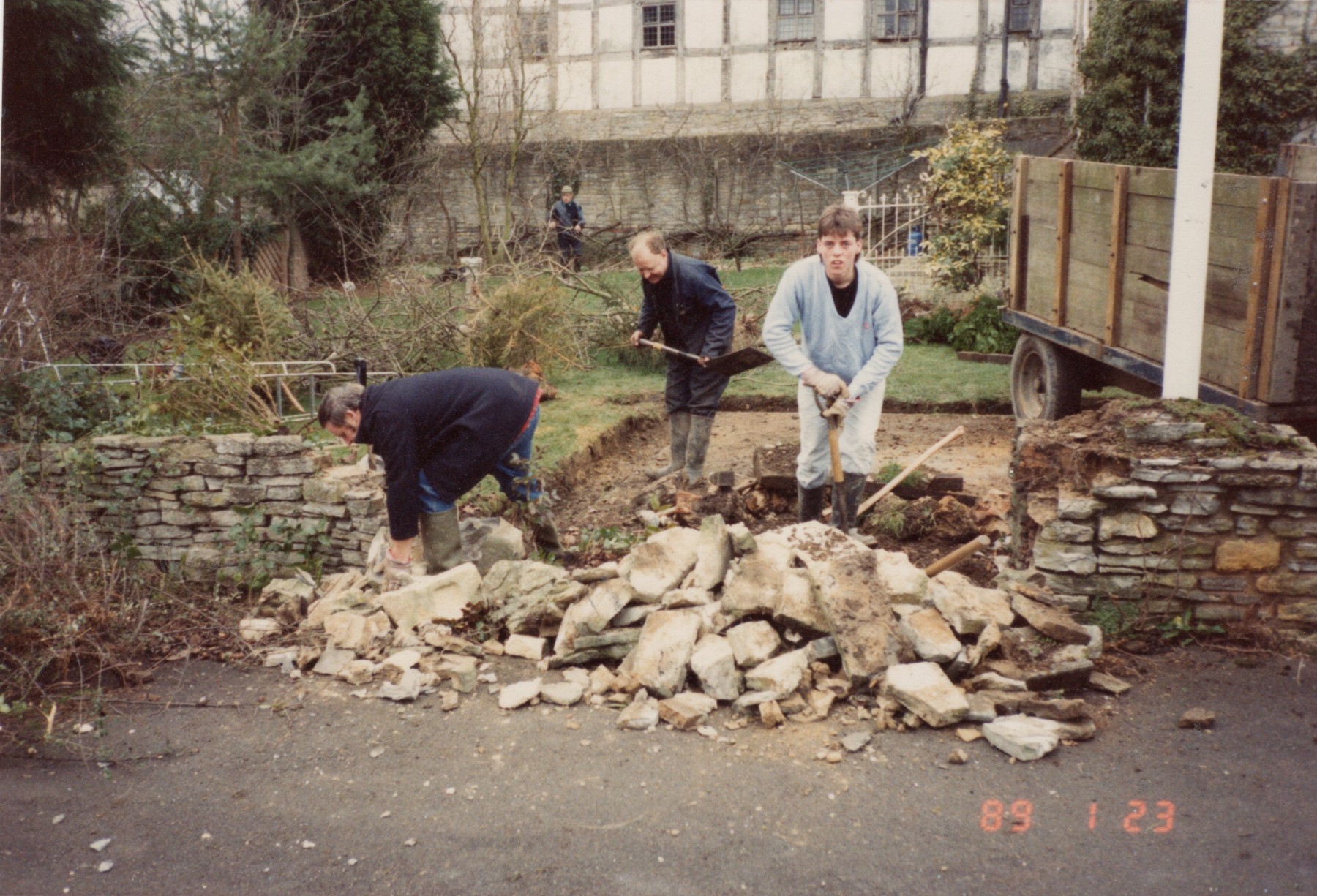

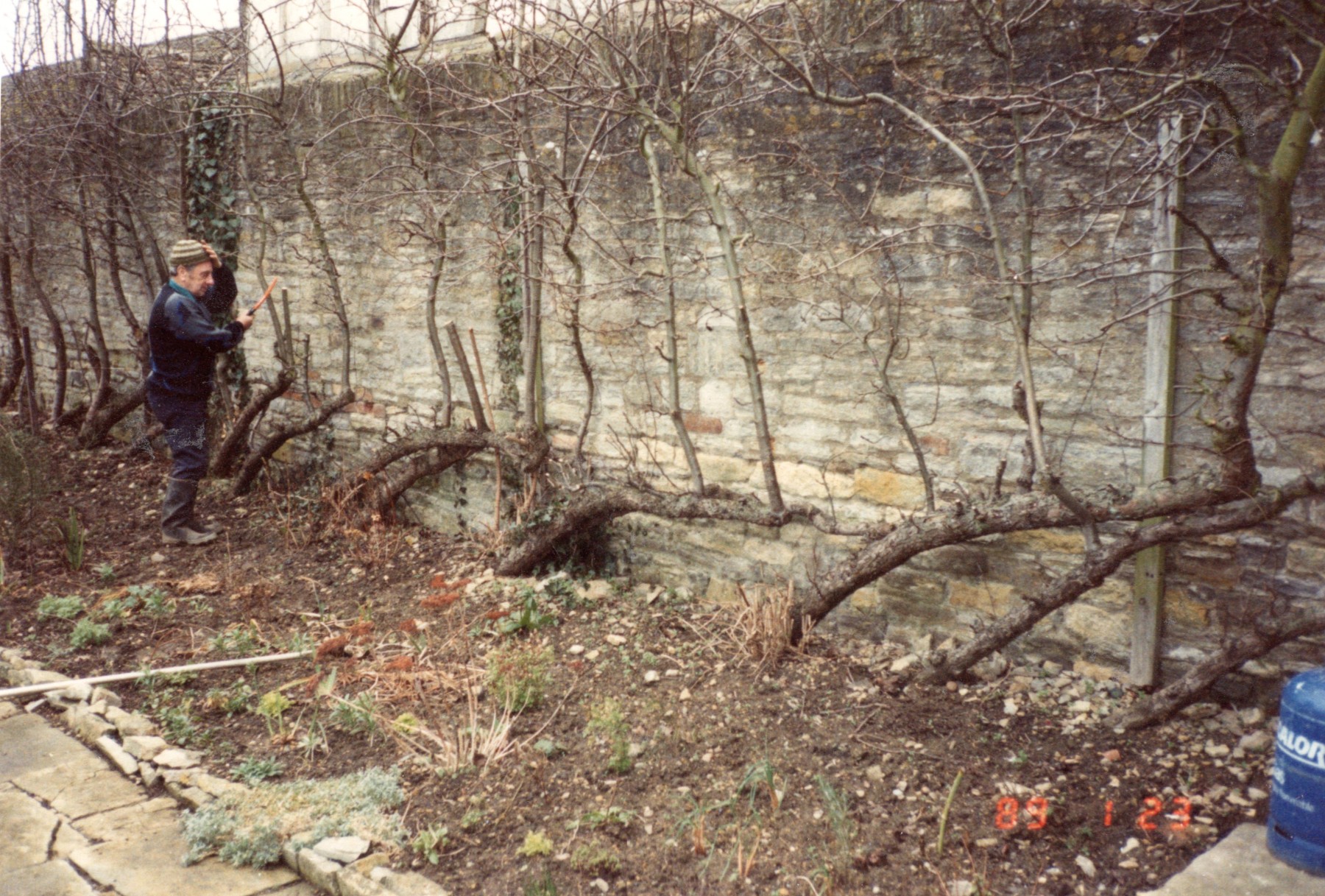

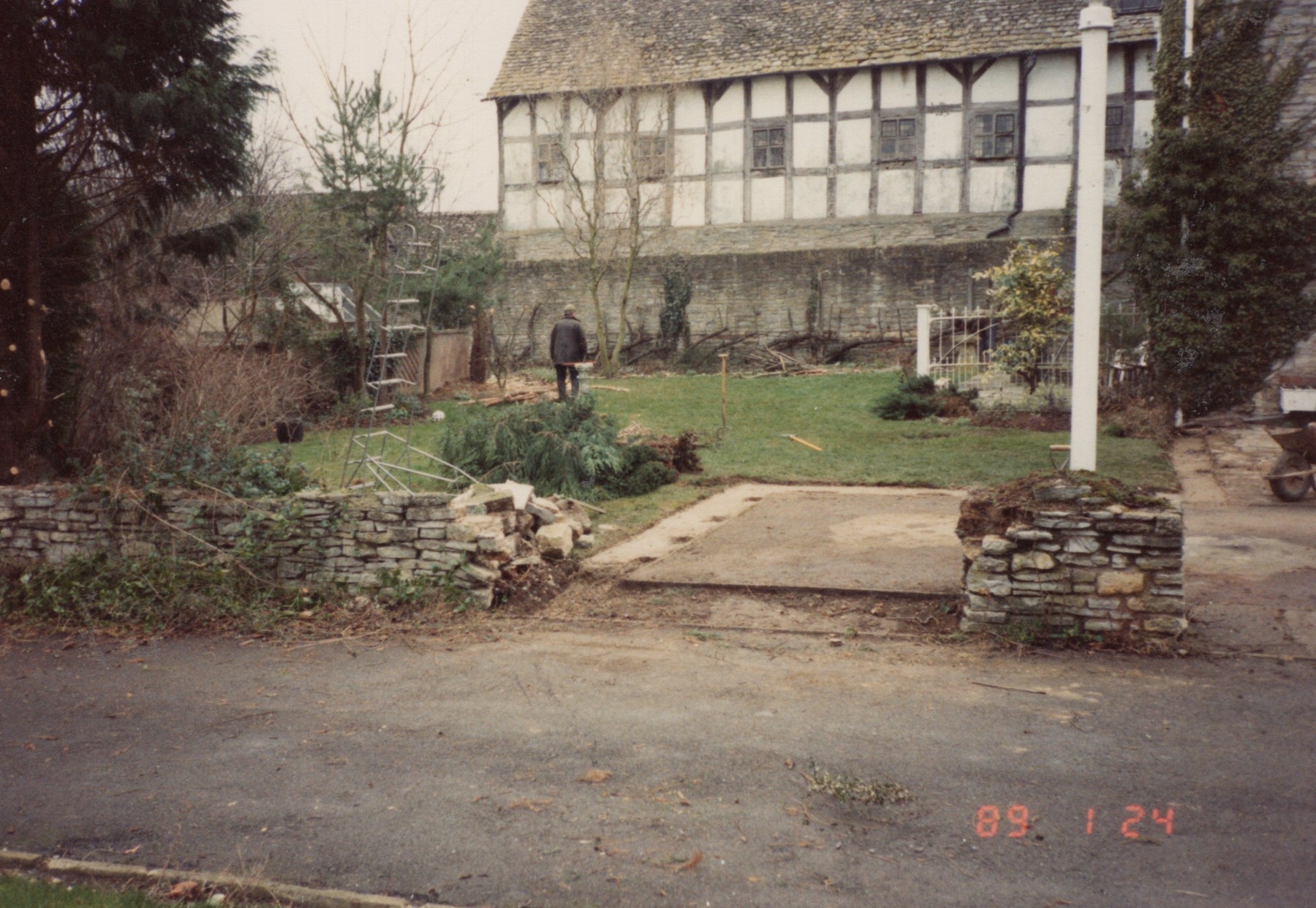
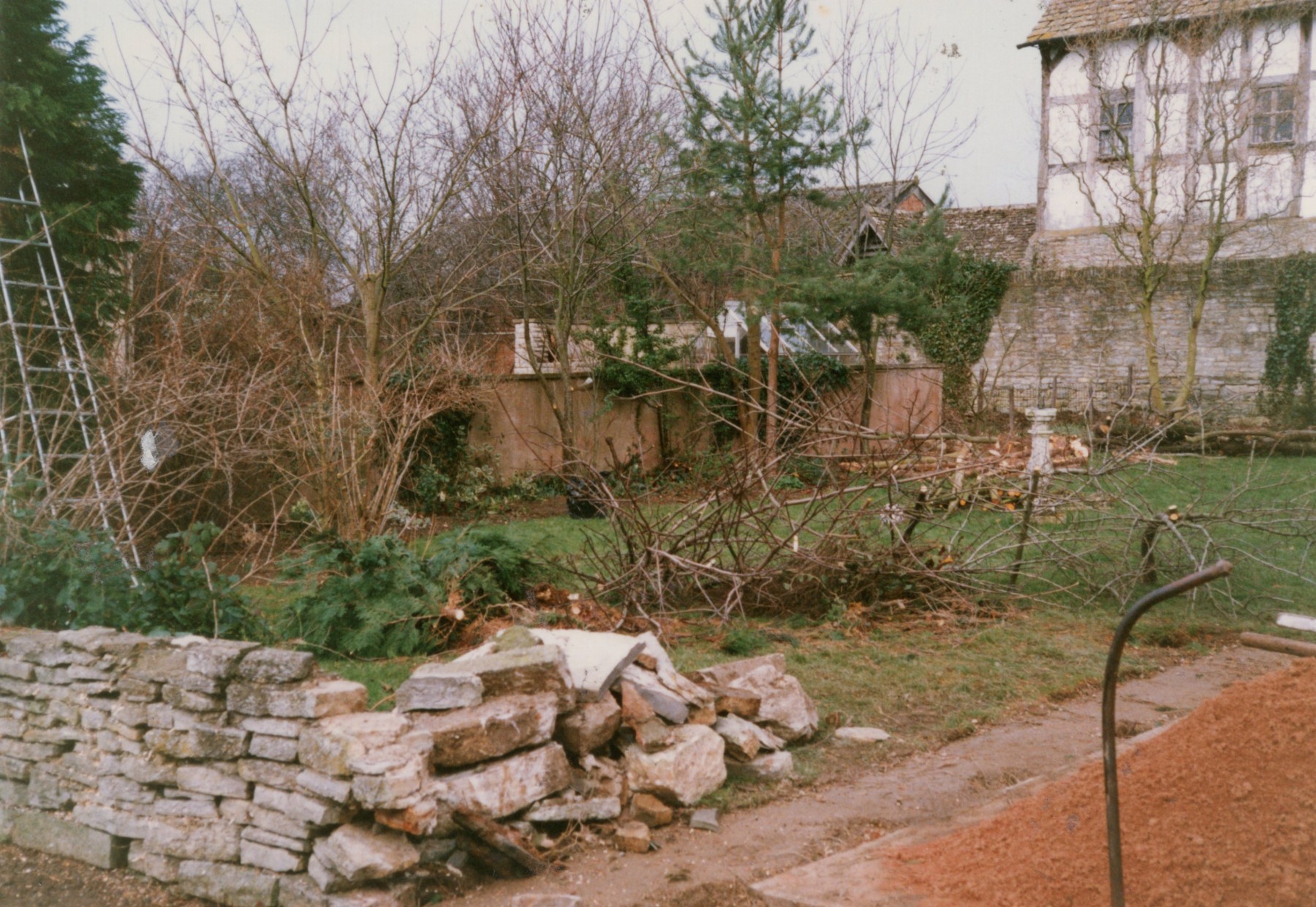
Next they tackled the interior to create a scheme more in sympathy with the period of the house. Barbara was a talented home designer, had an eye for quality items to place in their new home, made all the curtains, and loved flower arranging. A five-page article about the redesign of Harrington House appeared in the August 1996 edition of Cotswold Life.
The kitchen was left until last as it needed a major redesign in order to create the original farmhouse ambience. They had heard rumours of a concealed bread-oven behind the inglenook, and this indeed, was the case.
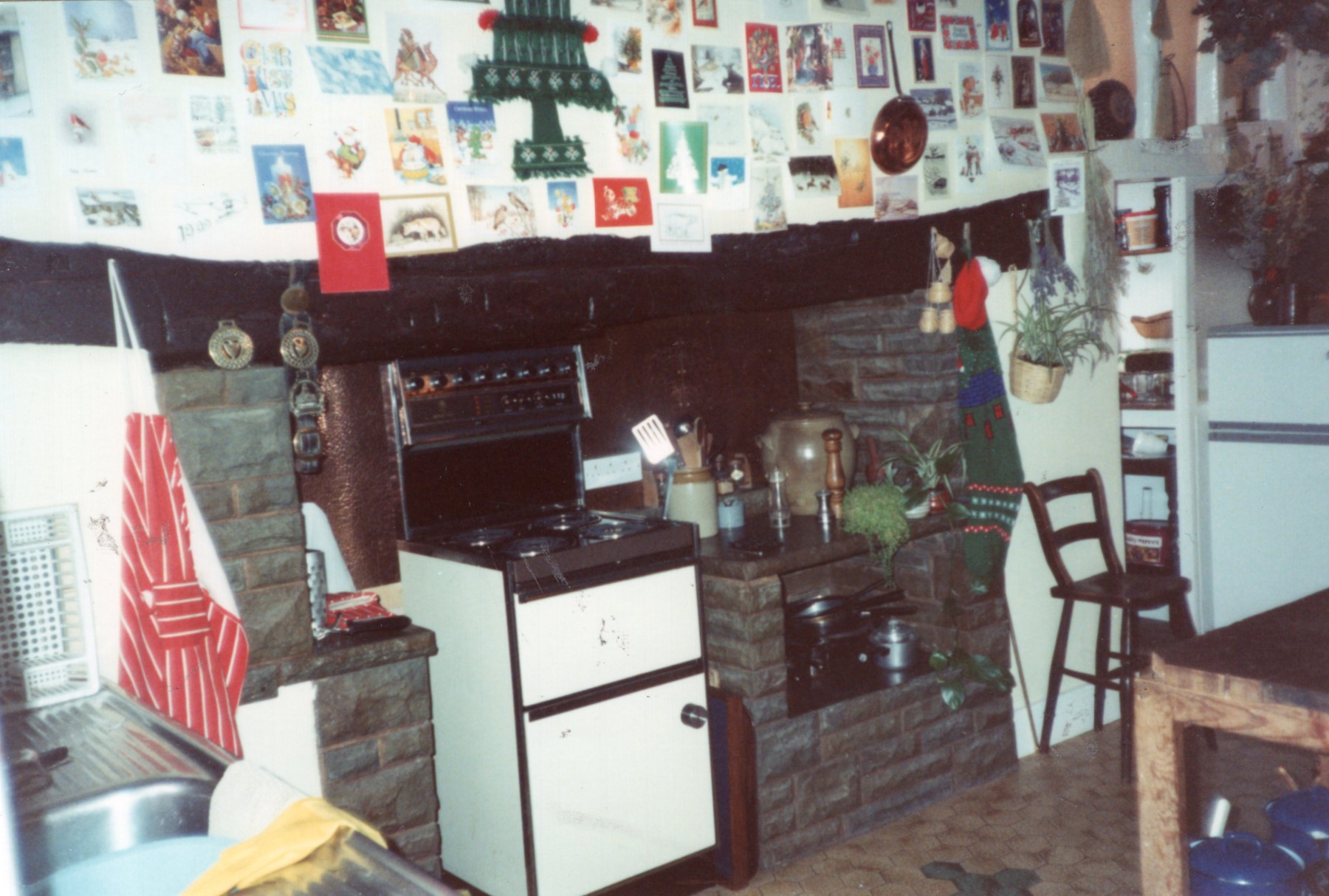
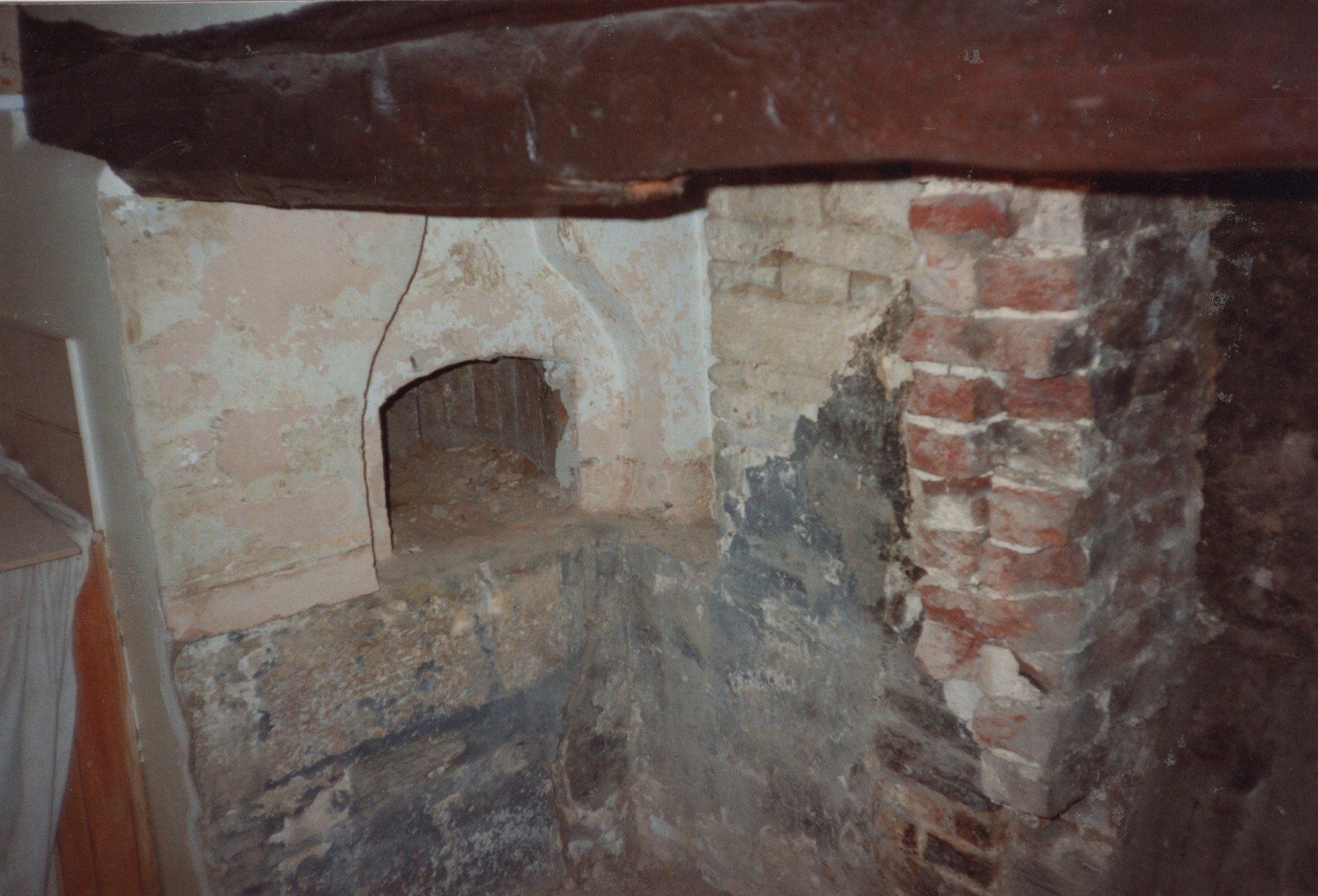
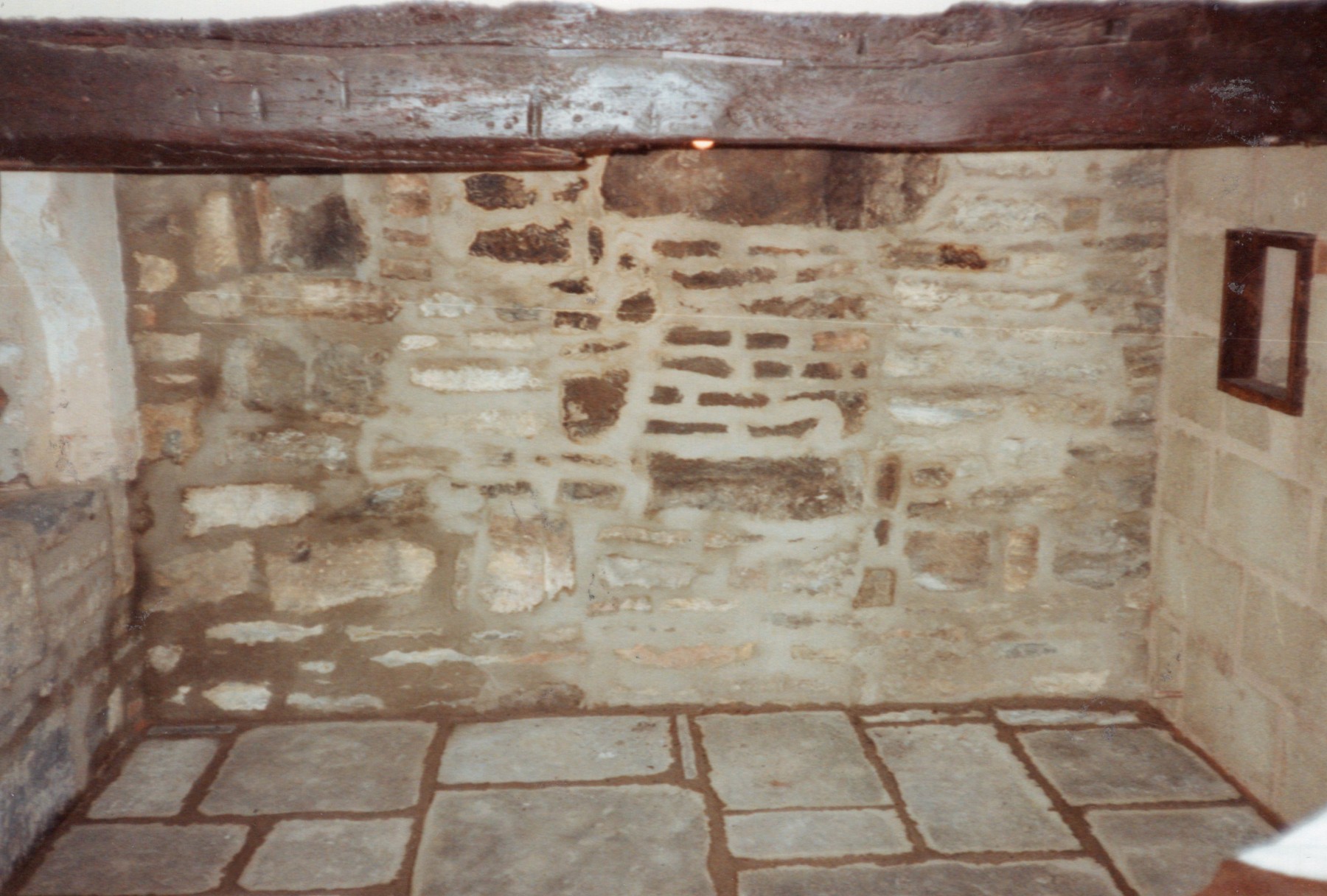
The photos below show the kitchen after renovation c1990.



In 2006, Peter Stewart took these photos of the kitchen and of the house exterior. The bread oven can clearly be seen in the photo on the right.
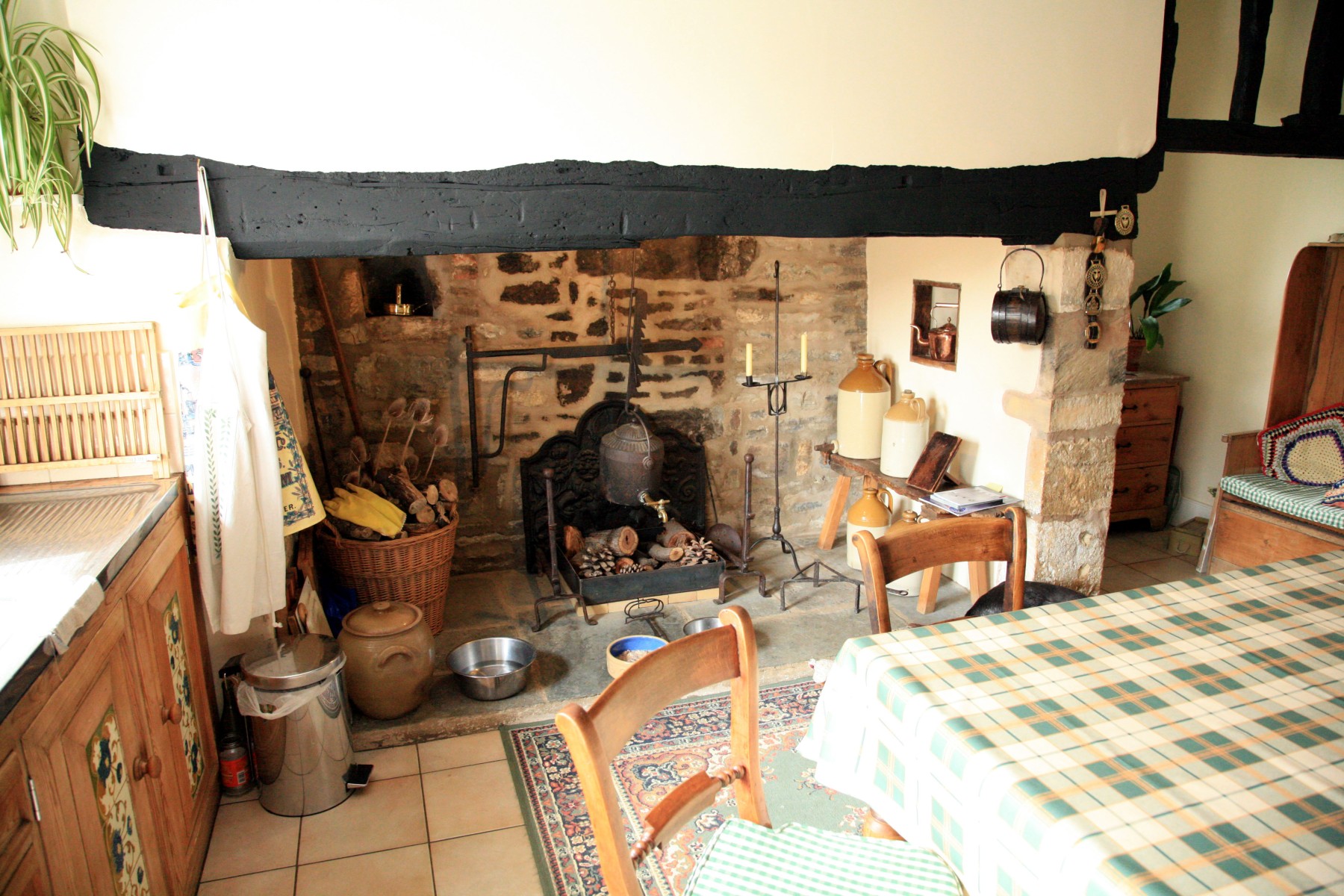
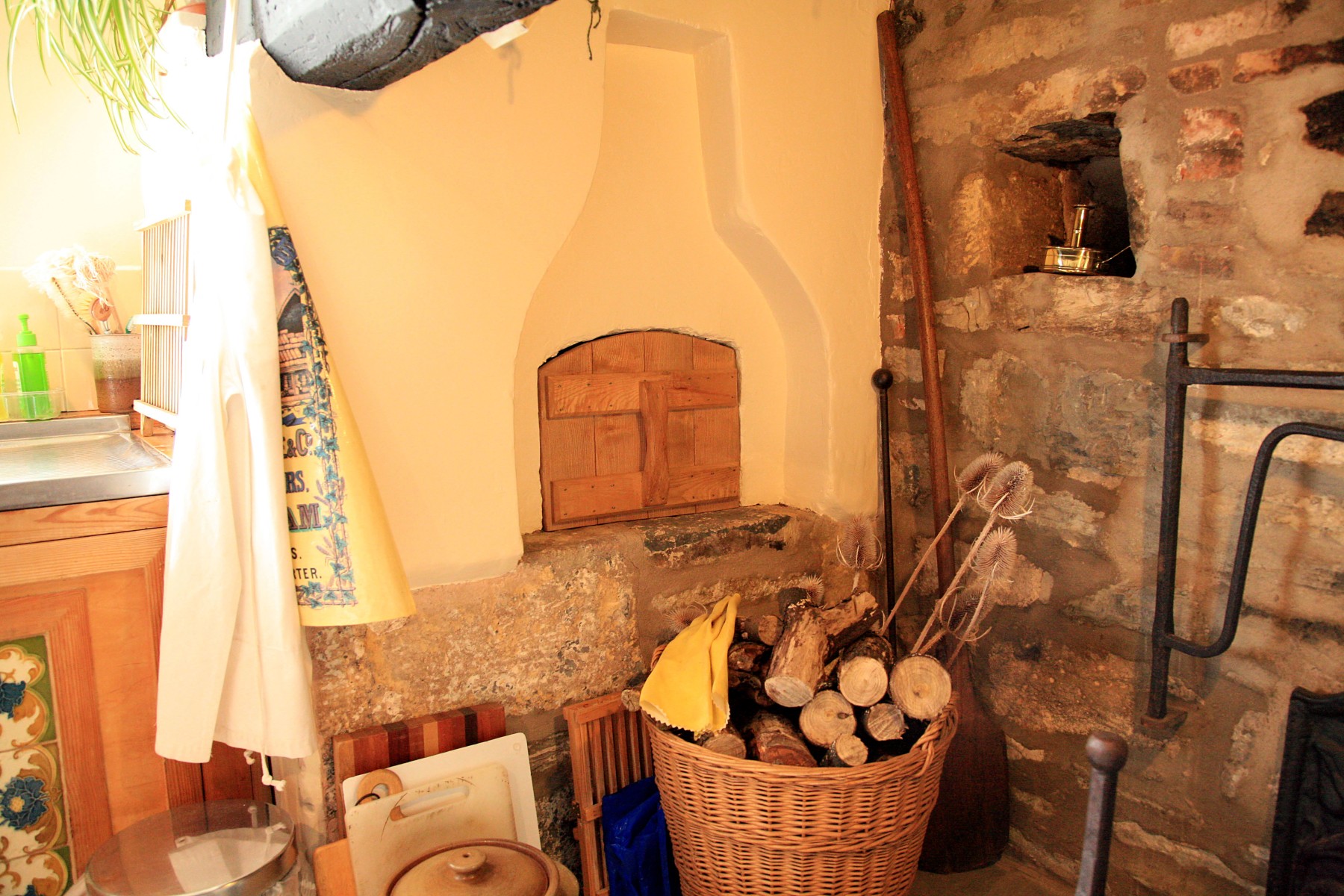
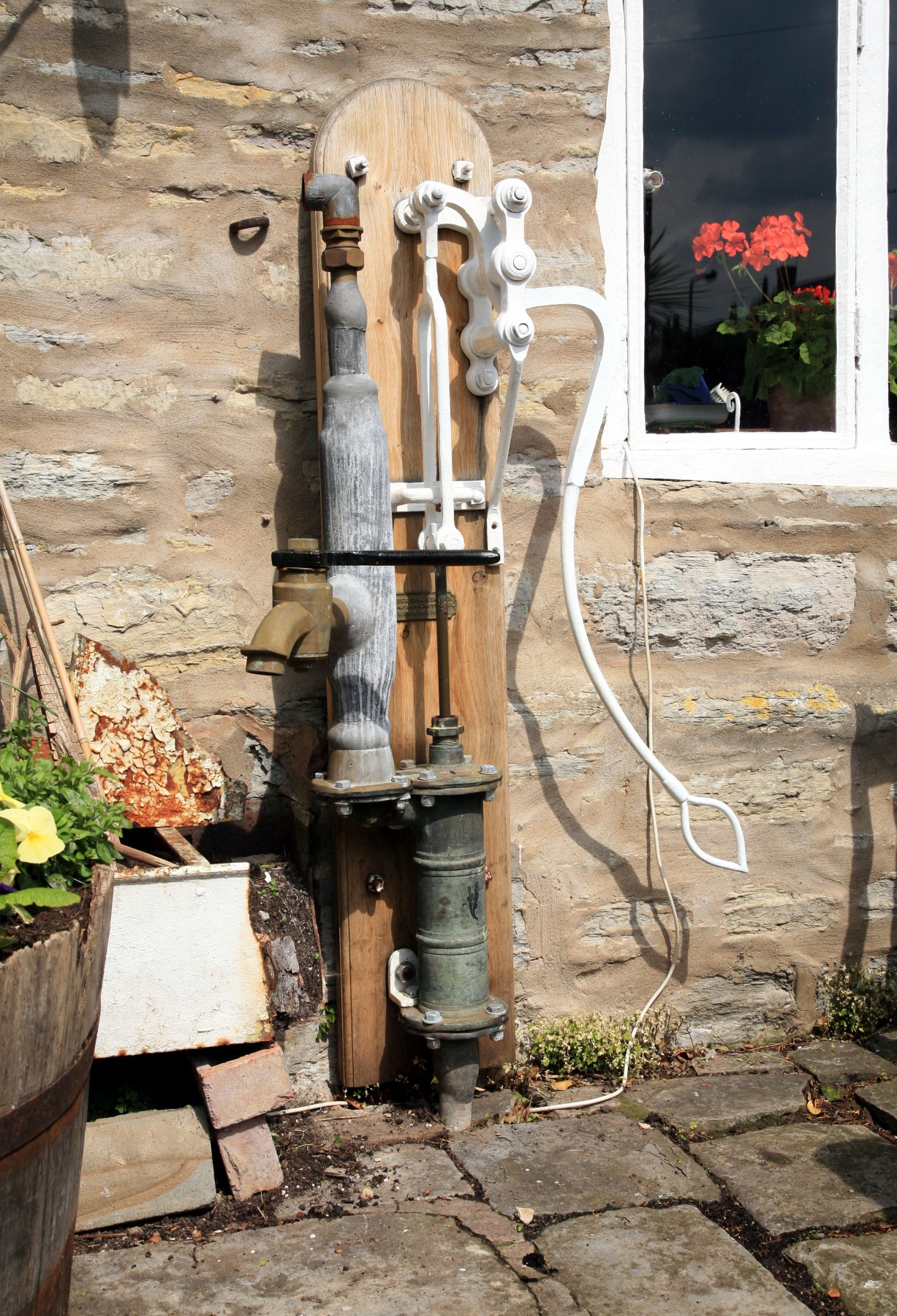
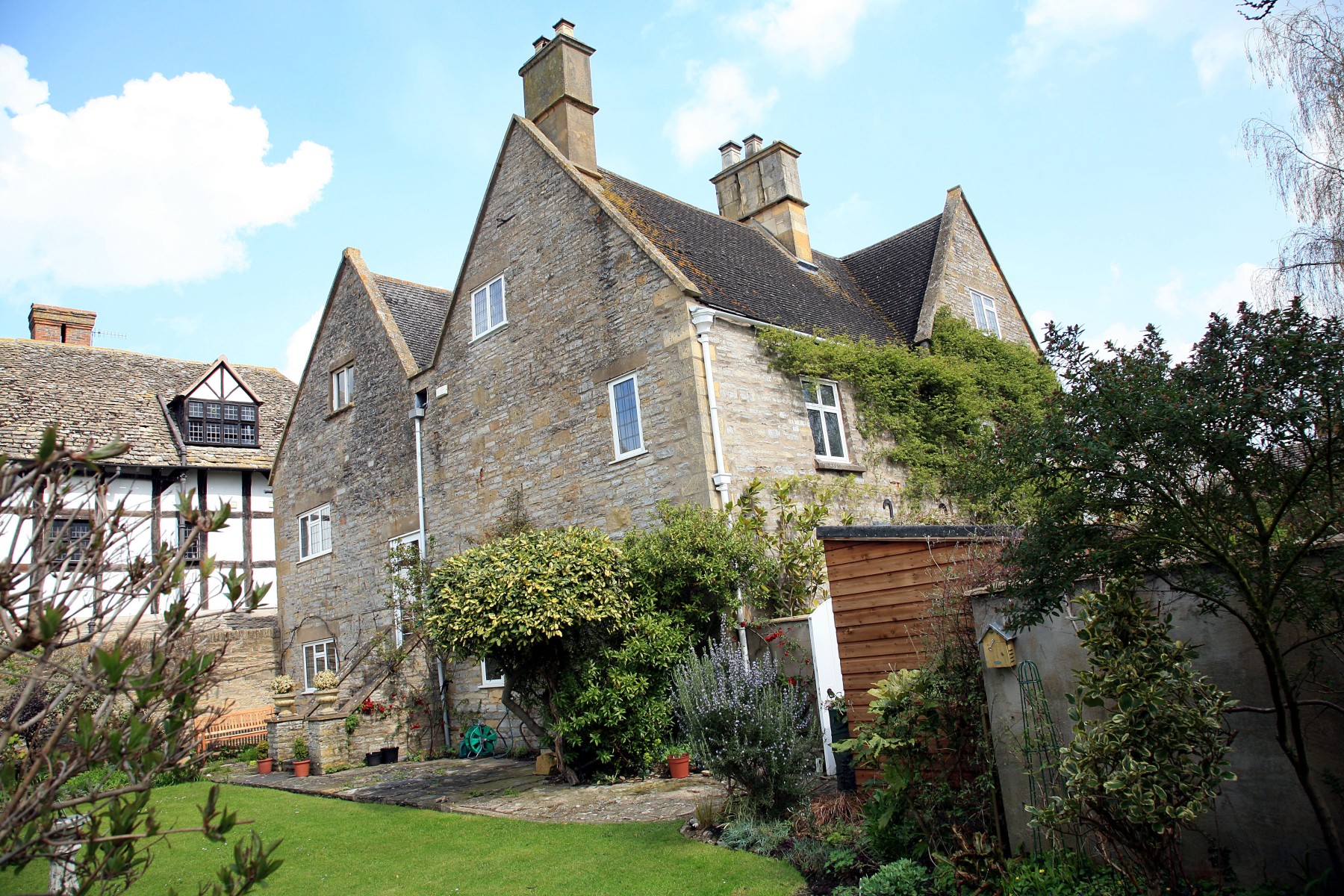
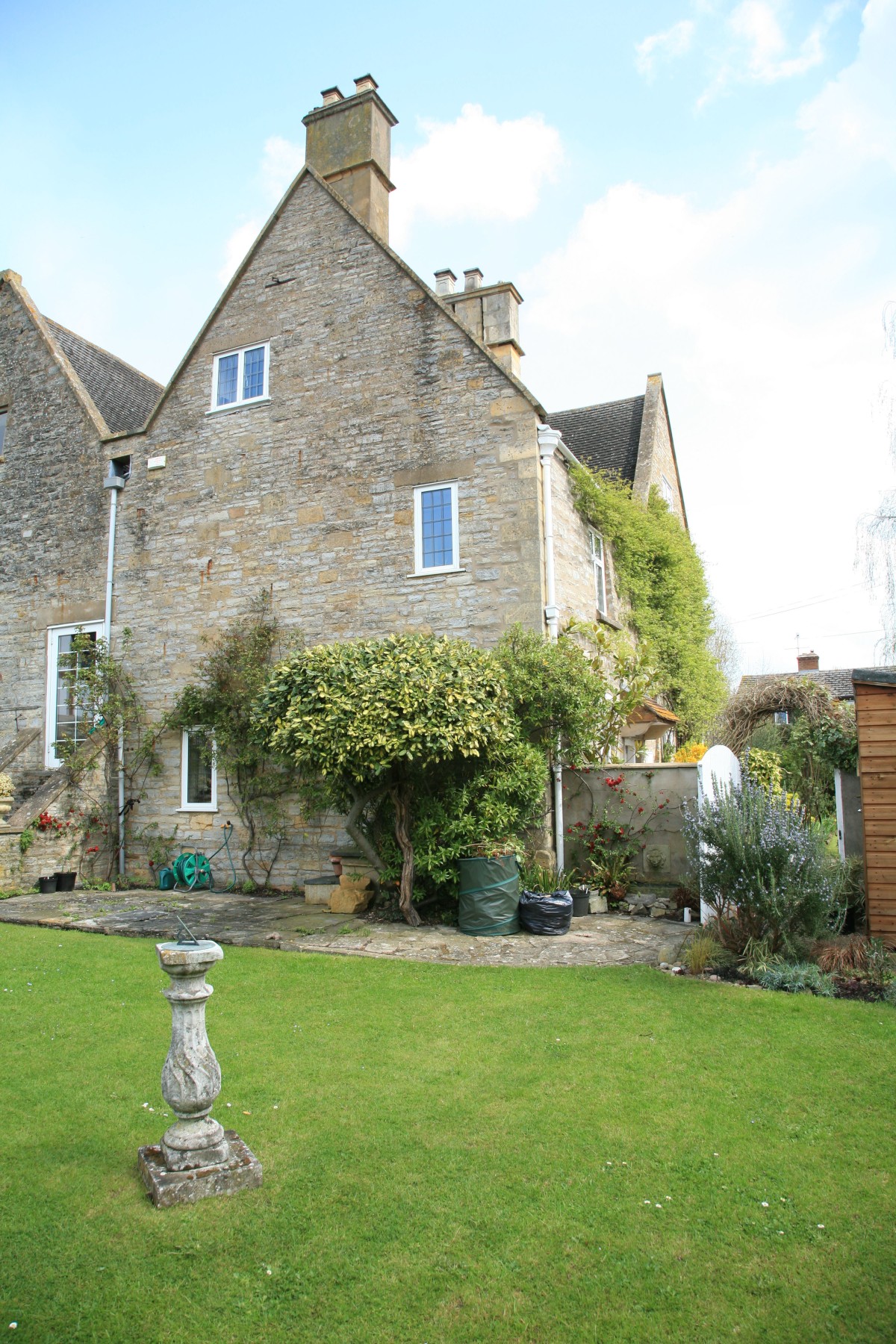 Nearly 20 years after having bought Harrington House, an amazing connection was found linking Tony Jerram to the owners in the 19th century, the Appelbees. Thomas Appelbee (1831-1879), the son of Edward and Elizabeth Appelbee who owned the house from about 1828, was a bank manager for the Gloucestershire Bank. He had grown up at Harrington House but, in adulthood, lived firstly in Tewkesbury and then in Evesham. What first alerted us to a possible connection between the 19th century and 21st century occupants of Harrington House was the intriguing name of Thomas’ sixth child, Francis Jerram Appelbee, born in 1870. Usually, when a surname appears as a middle name, it means that it was the mother’s maiden name. It transpired that Thomas’ wife, Hannah, had been born in London, the daughter of John Jerram, a tea dealer. The question was, was she any relation to Tony’s ancestors, who were also living in London at the time?
Nearly 20 years after having bought Harrington House, an amazing connection was found linking Tony Jerram to the owners in the 19th century, the Appelbees. Thomas Appelbee (1831-1879), the son of Edward and Elizabeth Appelbee who owned the house from about 1828, was a bank manager for the Gloucestershire Bank. He had grown up at Harrington House but, in adulthood, lived firstly in Tewkesbury and then in Evesham. What first alerted us to a possible connection between the 19th century and 21st century occupants of Harrington House was the intriguing name of Thomas’ sixth child, Francis Jerram Appelbee, born in 1870. Usually, when a surname appears as a middle name, it means that it was the mother’s maiden name. It transpired that Thomas’ wife, Hannah, had been born in London, the daughter of John Jerram, a tea dealer. The question was, was she any relation to Tony’s ancestors, who were also living in London at the time?
The clue lay in the 19th century census returns. These revealed that Hannah’s father was born at Blidworth, Nottinghamshire, and Tony’s great-great-grandfather was born at Breaston, Derbyshire. Breaston is just 17 miles from Blidworth, and it did not take the family historians long to make a connection. Hannah Jerram (1838-1872) was a close cousin of Tony’s great-grandfather. How amazing that two members of the same family, born a hundred years apart and not originally connected with the Worcestershire area, should end up living in the same house in Badsey!
Sadly, within a few months of having established the connection between the Appelbees and the Jerrams, Tony Jerram died suddenly of a heart attack in the garden of Harrington House on 3rd April 2008. Nearly 300 people crammed into St James Church, Badsey, for his funeral.
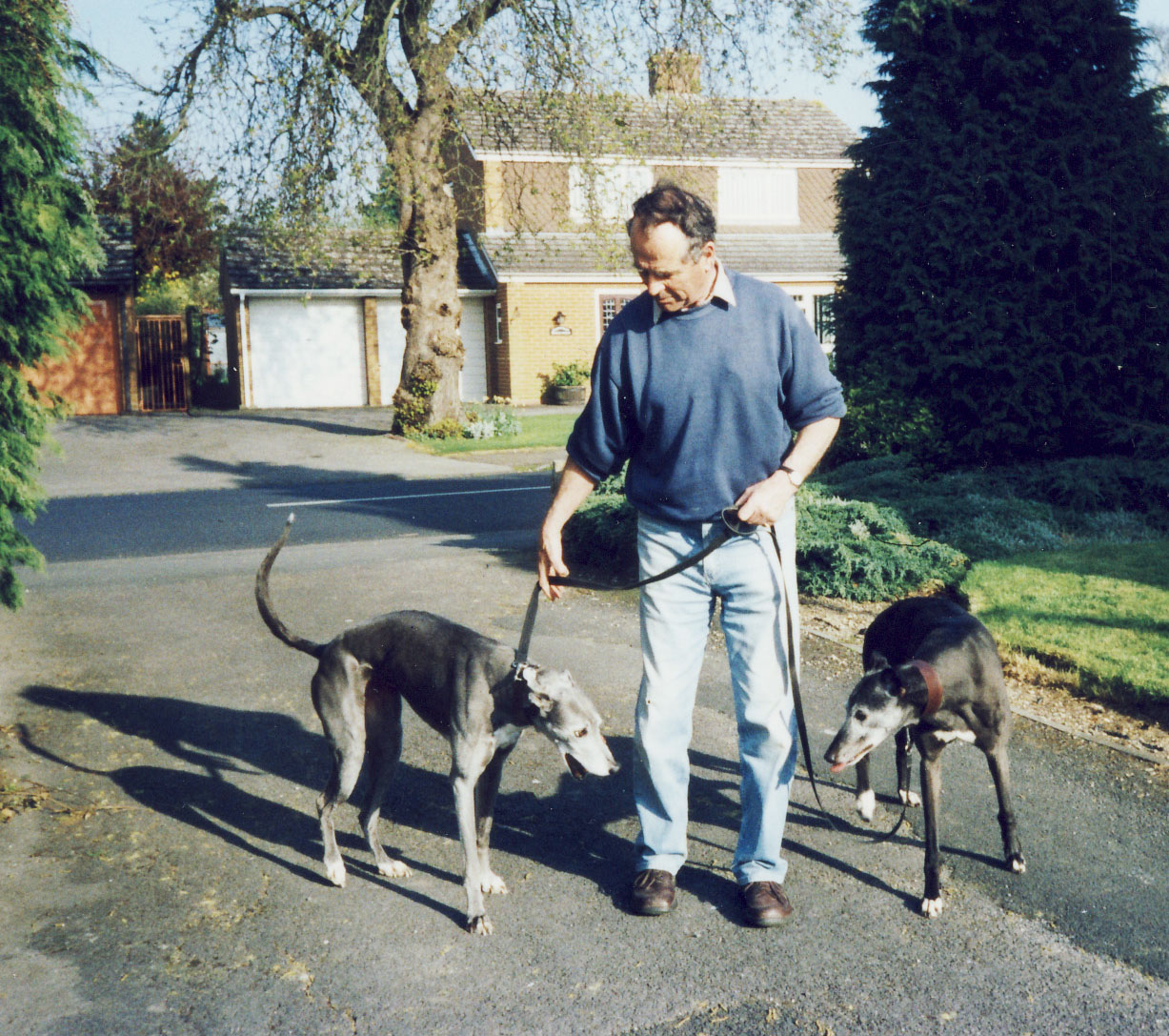
Harrington House was briefly put on the market after Tony Jerram’s death, but Barbara then decided to remain in her home. Barbara lived at Harrington House, initially alone but then, from 2019, with her son and daughter-in-law, Garry and Yana Smout. Barbara loved her garden and looked forward each year to the arrival of the swifts which nested under the eaves of the adjacent Manor House.
By 2024, Barbara’s health was declining. The swifts had left for the summer and now it was time for Barbara to depart. She died peacefully at home on 31st August 2024, aged 92.
As was Barbara’s wish, there was no formal funeral. Instead, she was cremated quietly at the Vale Crematorium, Fladbury. Her ashes were laid to rest in the garden of Harrington House.
* * * * *
Harrington House will very soon welcome new owners and the house will enter a new chapter in its history.
Maureen Spinks, July 2025
See also:
- Wills of Francis Grove, John Grove, John Jones, Joseph Jones,
- Letting of Harrington House, 1813
- Sale of Harrington House, 1828
- Sale of Harrington House, 1891
- Wills of John, Elizabeth, Mary and Sarah Harrington
- Badsey Enclosure Award Schedules, 1815
- Will of Thomas Scardefield
- Wills of Edward Appelbee and Elizabeth Appelbee
- Census returns
- Valuation Survey
- Newspaper articles, 1969 and 1971
- Tony Jerram (1937-2008)
- Barbara Jerram (1931-2024) – farmer’s wife/army wife/African adventuress
Other Sources of Information
- Birmingham City Archives – MS3192/Acc1930-009/362809,362813 (1795, Sale from Darrill to Harrington)
- Birmingham City Archives – MS3192/Acc1930-009/362809,361765 (1790, Mortgage Harrington House)
- Samuel Johns – Notes on Harrington House
Acknowledgements
- Garry Smout for the loan of various photographs and documents
- Spinks family for access to the Abstract of Title and other documents relating to 8A High Street which was built in the back garden of Harrington House
